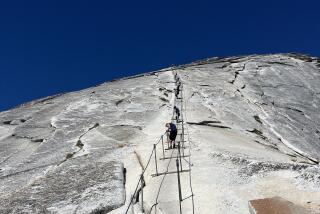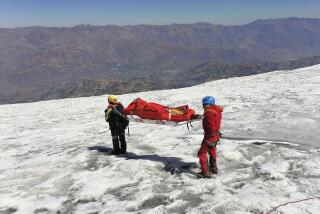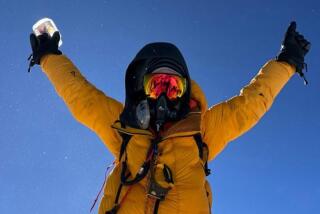Young Climber Ascends Into Media Spotlight
- Share via
TOKYO — The climb was littered with the eerie reminders of failure --frozen corpses, feet sticking out of the ice. But not until Ken Noguchi reached the summit of Mt. Everest did he start to feel afraid.
Standing at the top of the world with four Sherpas, Noguchi saw a cloud coming his way and knew it could be the harbinger of a storm, which can be deadly on Everest’s rarefied heights.
“That’s when I realized what a frightening place I was in,” he says.
So he quickly began his descent, bringing with him one of the most coveted trophies in mountain climbing: The Everest assault made Noguchi the youngest person to scale the Seven Summits, the highest mountain on each continent.
“It wasn’t until I came back to Base Camp that I realized that I had made it out alive,” he says.
Noguchi, a 26-year-old college student, completed his odyssey with the Everest climb on May 13, when he was still 25, and has been in the media spotlight in Japan ever since.
Japan’s leading newspaper hailed his success, and a TV network turned the climb into a documentary. He has appeared on the cover of magazines such as the popular weekly AERA and the Japanese edition of Playboy.
Along with Everest, the Seven Summits are Aconcagua in South America, McKinley in North America, Kilimanjaro in Africa, Elbrus in Europe, Vinson Massif in Antarctica and Kosciusko in Australia.
Some mountaineers take issue with the last peak, arguing that the 7,310-foot Australian mountain should be replaced by the 16,500-foot Carstensz Pyramid in Indonesia, which is the tallest peak in Oceania.
Noguchi climbed Kosciusko but hasn’t climbed Carstensz. The youngest person before Noguchi to scale the Seven Summits, Sundeep Dhillon of Britain, who completed it at age 28, climbed both, according to Everest News, an Internet site about Everest and mountain climbing in general.
Noguchi, who is 5-foot-6 and weighs 141 pounds, says he isn’t concerned that some diehards may not accept his title unless he climbs the Indonesian peak, something he has no plans to do.
“I’ve had enough of climbing. The Seven Summits were my goal,” he says. “But I don’t want to be only good at one thing.”
Noguchi’s climb up Everest capped a mountaineering career that began at age 15, when he was inspired by an autobiography by Naomi Uemura, a famous Japanese adventurer.
Noguchi’s first Seven Summit peak was Kilimanjaro in 1989. Then he almost followed Uemura’s fate when he made a solo attempt to climb McKinley, where Uemura died in 1984. Ironically, a device Uemura designed saved Noguchi’s life when he fell into a crevasse.
Noguchi says the unstable weather of Vinson Massif frightened him.
He suffered severe mountain sickness when climbing Elbrus and had to be carried down by the local staff. But he was back four months later to make it to the summit in 1996.
It took him three tries to get to the top of Everest.
In 1997 he was so worn out he couldn’t even make it to Camp Four, which is 26,190 feet above sea level. The following year, bad weather forced Noguchi to turn around just 400 yards below the summit.
“I knew if I failed three years in a row, there wouldn’t be another chance,” says Noguchi, who relied for financing on several Japanese companies.
With surprisingly good weather, Noguchi and four Sherpas began the final leg to the summit at 10 p.m. on May 12, climbing from Everest’s south ridge.
Along the way, in the dim light of his headlamp, Noguchi saw the legs of a dead climber, frozen. Three more bodies lay ahead.
“I tried to think they had nothing to do with me,” he says, adding that his mind was losing its clarity because of fatigue and the altitude.
Eleven and a half hours after leaving Camp Four, they were at the summit, 29,028 feet up. He stayed for only about 15 minutes because of the approaching cloud.
Noguchi says that after graduating from college next March he wants to become a photojournalist. His book on his climbing career, “A Dropout on Everest,” is due out soon from the Shueisha publishing company.
And though he says he is no longer interested in climbing for trophies, he does want to go back to Everest one more time to help clean up the trash that climbers leave, and possibly set up a fund for Sherpas.
“I think I’ve been lucky and have been helped by other people,” he says. “But I wonder if I should stop before I use up all my luck and end up dead myself.”
More to Read
Sign up for Essential California
The most important California stories and recommendations in your inbox every morning.
You may occasionally receive promotional content from the Los Angeles Times.










